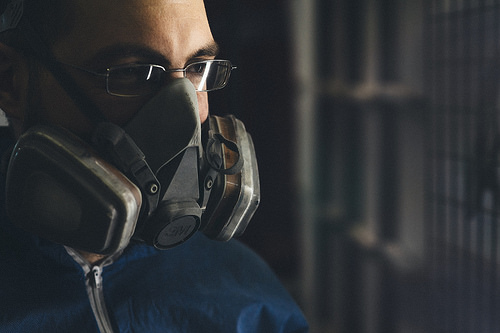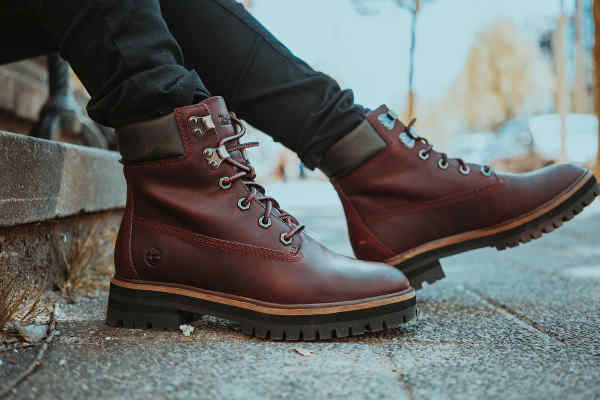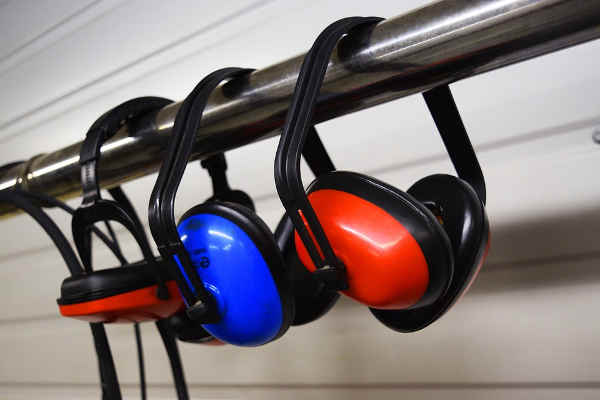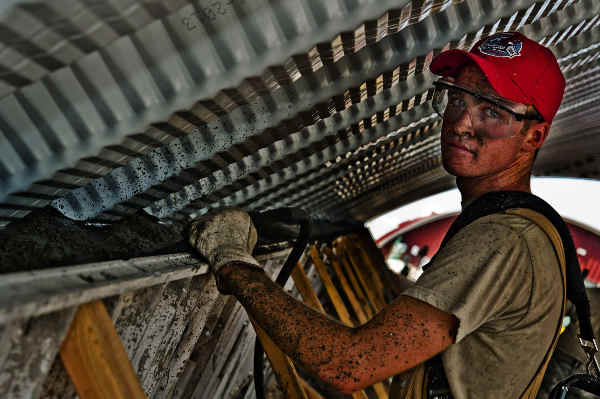One of my wife’s biggest concerns when I started blacksmithing was safety. She wanted me to make sure that I was using all the safety equipment I needed to prevent myself from getting injured.
What safety equipment do blacksmiths need to use? Blacksmiths can use basic personal protective equipment like safety glasses, a respirator, non-synthetic clothing, earplugs, and proper footwear to prevent injuries. Some blacksmiths choose to wear gloves, while others find them too cumbersome to work in.
As a beginner blacksmith, I know that staying safe is a big concern. In this article, I’ll discuss the necessary safety equipment you’ll need to keep yourself safe from head to toe while forging. At the end, I’ll provide some additional safety tips to keep you safe as well.
To see the safety equipment I personally recommend, be sure to check out my recommended gear page.
A Good Pair Of Safety Glasses

Proper eye protection is at the top of the list for safety equipment. I know one blacksmith who had scale get into his eye while twisting some metal. Luckily he didn’t lose his sight, but they had to drill into his eye to remove the shrapnel from his iris, and it took weeks to recover.
That was a gruesome enough story for me that I’ll never step foot into my shop again without proper eye protection.
Get a pair of safety glasses with polycarbonate lenses that offer UV protection. That will stop most of the harmful light radiation from blacksmithing from reaching your eyes.
Safety glasses with shade 3 or 4 flip-ups can be useful for when you’re looking into the forge. It will help reduce your eye fatigue. But it’s really more to prevent seeing black spots after looking into the intense light than anything else.
The downside is that it’s harder to see the color of your work because of the green tint. Although if you use them all the time, your eyes can adapt and adjust.
Your safety glasses will protect you from small pieces of metal being thrown into your eye, as well as splashes of corrosive or hot liquids, and even prevent irritating vapors or gas from getting in contact with your eyes.
A Respirator

Photo credit: Maxim Mogilevskiy via Flickr
A paper dust mask doesn’t count as safety equipment for blacksmithing. It’s not enough to filter out potentially harmful chemicals when you’re working with coal and molten metals. They don’t have a rubber facepiece to create a proper seal, and they don’t have any real filtering capabilities.
A particulate respirator with a HEPA rating is your best choice.
Be careful using a respirator if you have any breathing issues like asthma or any heart conditions. Using a respirator causes extra stress to your lungs which can make matters worse, or even put a strain on your heart.
Also be aware that a respirator can’t correctly seal if you have facial hair where the rubber face piece sits. If you’ve got a beard, you’ll need to trim it down so that you have bare skin where the respirator needs to seal to your face.
If you’re able to smell it, taste it, or see it, then it’s not air. You should be using a chimney to remove the bulk of the pollutants while you’re smithing, but you definitely need a good respirator to filter out anything left behind.
Non-Synthetic Clothing

You wouldn’t think of cotton as safety equipment, but it can save a lot of discomfort while blacksmithing.
Clothes made of polyester or other synthetic materials can melt and stick to your skin if they get too hot, which isn’t a fun trip to the emergency room.
Natural fibers like cotton are best. Try to wear as thick of a material as you can, given the weather conditions. A flannel jacket is going to be too hot to work in during the middle of summer but do the best you can. For your legs, jeans are an excellent way to go any time of year.
Sparks will fly unpredictably while you’re blacksmithing, so long sleeves and long pants are best.
Try to avoid loose clothing so it won’t get tangled in anything or catch falling molten materials.
You likely will get coals that burn through your clothing over time, so it’s best to use clothing you don’t mind getting damaged, or having a specific set of clothing you wear during blacksmithing.
A denim or leather apron can help provide an extra layer of protection.
Footwear

You need to protect your feet from any red hot falling pieces of metal. Trade out those running shoes for some leather boots. Steel toed boots are good, but boots with a metatarsal guard are even better and protect the other small bones further up your feet.
Not only will a good pair of boots prevent injuring your feet if you drop a massive piece of steel on them, but they also protect against the hot scale and little bits of steel that will be falling off your work.
If you’ve got back problems, a good pair of orthotic inserts can make standing for long periods a lot more comfortable.
Earplugs

The noise of a hammer hitting metal while you’re forging can reach more than 85 dB. That’s enough to cause progressive hearing loss over time. Aside from that, it’s also just uncomfortable to work in noisy conditions.
Earplugs can feel weird and make you feel isolated and closed off from the world. But when the alternative is needing a hearing aid in 20 years, I’ll stick with the earplugs.
You can get noise-canceling earmuffs that have a radio built in. That way you can save your hearing while also listening to music while you work. They also keep your ears warm in the winter.
Even forging without ear protection for short periods can cause damage, so it’s better safe than sorry.
Earplugs are cheap and easily replaced so it might be worth trying a few different brands to see which are most comfortable for you. You’re more likely to wear them if they’re comfortable.
Fire Extinguishers
At the most basic level, you should have a 5 gallon bucket of water nearby to put out any small fires, or in case you burn yourself. Your bucket can also double as a quench tank, so it’s worth having around.
Ideally, you should also have an actual fire extinguisher.
There are different types of fire extinguishers including water, foam, dry powder, CO2, and wet chemical. Different types of extinguishers are needed to put out different types of fires.
Some will work on combustible materials like coal and wood, while you will need a different type of extinguisher for flammable gasses like propane or natural gas.
Make sure to research and have a type of extinguisher that works with the class of fires you may need to deal with.
Gloves

The use of gloves is a bit more iffy among blacksmiths. Some use this kind of safety equipment, some don’t.
If you’re twisting metal, I feel like gloves are mandatory to prevent scale from falling on your hands. But otherwise it’s more optional.
There are welding gloves which are designed to be removed quickly, but they’re a bit too cumbersome for blacksmith work. Leather gloves are better, and you can buy them at pretty much any hardware store.
If you’re wearing regular working gloves, it might be worth cutting the cuff off of the back of them. That will prevent the cuff from funneling hot material down in toward your hand, and they’re less likely to snag on something.
Never wear gloves around things like a lathe or drill press where they can get caught and pull you into the machinery.
Additional Safety Tips
Start with a light hammer. It can be easy to strain yourself if you’re brand new to blacksmithing. Start off with a light hammer that weighs only 1.5 to 2 pounds while you’re still learning proper technique and building up your muscle. Then you can build up to a heavier weight when you’re ready. Just make sure you get a weight that you can use without discomfort for hours at a time.
Stop if you get tired. If you entirely miss the metal with your hammer, it’s time to stop and take a break for half an hour. If you miss twice, it might be time to call it a day. That’s your body’s way of telling your brain that it can’t perform any more. Once your swing accuracy starts to go, your risk of injury goes up dramatically.
Stay well hydrated. Blacksmithing is hot, sweaty work. You’re going to lose more fluids than you think, so drink more than you think you need.
Aloe vera. Keeping a bottle of aloe gel nearby can be useful if you burn yourself. It can soothe damaged skin including blisters and small burns.
Watch out for repetitive strain injuries. You’re swinging a hammer the same way hundreds of times in a row. That’s prime conditions for developing a repetitive strain injury. Be sure to use good hammer technique, and be conscious of any shoulder, elbow, or hand pains and aches that might mean it’s time to take a break. One common beginner mistake is putting your thumb on your hammer’s handle instead of wrapping it around the handle.
Use your brain. When it comes to safety, your brain is the most important tool you have. Common sense and proper education can help prevent the vast majority of injuries. Never blacksmith while your brain isn’t working 100%, like while drinking alcohol, taking cold medicine, or even if you’re just feeling sleepy. If you can’t focus completely, leave the forge for another day.
Have any close calls that you avoided by wearing the correct safety equipment? Feel free to share your story below!

